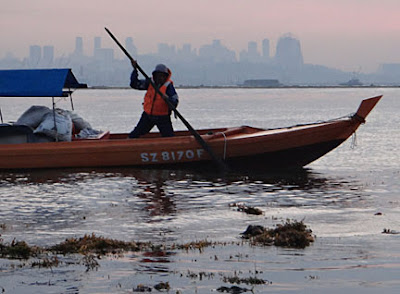It's the first predawn trip of 2013, and we visit South Cyrene and Cyrene Reef in one trip!
I've been kindly invited to help at the Mega Marine Survey recce trips for the upcoming Southern Expedition in May. We have lots of ground to cover and few low tides, so we make many stops in one trip!
What we refer to as Cyrene is actually properly called Terumbu Pandan, the largest of the three submerged reefs that are collectively called Cyrene Reefs. The other two are the much smaller: Pandan Beacon and South Cyrene. I've visited South Cyrene before on Siti's trip in Oct 2010. It didn't seem much different today.
I took the opportunity to have a quick look at short stretches of both reefs.The corals seemed to be doing well on both Cyrene and South Cyrene. For the first time, I came across a living Circular mushroom coral at Cyrene (Fungia sp.). There are were also many other common corals and none of those I saw were bleaching.
I saw a small clumps of Spiky flowery soft coral (Family Nephtheidae) which was teeming with all kinds of creatures living among its 'branches'. There was a small False cowrie snail (Family Ovulidae) and many Tiny colourful brittle stars (Ophiothela danae).
There was also a small crab among the 'branches' of the soft coral.
I spent some time slowly looking through the seagrasses and under stones. There were little spotted fan worms, many swimming anemones, spidery crabs. And my first time seeing an orange sea cucumber on Cyrene. Under the stones, lots of brittlestars, snapping shrimps and bristleworms.
Under a stone, I saw what looks like a Rose nudibranch (Dendrodoris fumata) laying an egg spiral next to a red sponge!
I also came across some Glossodoris atromarginata nudibranchs and an Ornate leaf slug (Elysia ornata).
If I was a tiny animal these two bulbous things with waggling tentacles at the top might seem interesting enough to entice me to come closer. That would NOT be a wise move!
These are the eyes of a half buried Fringe-eyed flathead (Cymbacephalus nematophthalmus) (yellow arrows indicate its eyes). Its tail and body are not quite buried (at top left in the photo) The huge V-shaped mouth is just infront of the eyes and would chomp up tasty critters that came too close.
A cloud of ink is drifting among the seagrasses. Where is the cephalopod that squirted it?
Here's the octopus, perfectly blending in with the surrounding sand.
This other octopus remained immobile and pretended to be a green and brown algae-covered rock!
I also came across this cute little Whelk (Family Nassariidae) that I've not seen before. It has a white body speckled black and a pretty spiralling band around the shell. I'm not too sure yet what it is. [Update: Thanks to Tan Siong Kiat who identified the whelk as Nassarius limnaeiformis].
This colourful snail is probably some kind of Reef murex (Chicoreus sp.). The colour seems to be the shell colour and not some encrusting organism.
Another strange lump on a rock turned out to be a well camouflaged chiton!
Just before we left, I came across lots of tiny sea anemones stuck to a seagrass blade. They had purple-tipped tentacles. I'm not sure if it's yet another kind of seagrass sea anemone, or babies of some other kind of sea anemone.
Wow, a Very long ribbonworm (Baseodiscus delineatus)! With my foot as comparison. This pretty pajama-striped worm is a ferocious predator! To capture its prey, the ribbon worm has a unique eversible proboscis at the front end of the body. This is a hollow, muscular structure that can shoot out with explosive force and is prehensile (can be used to grip) and retractable (can be pulled back). The proboscis is usually wound around the prey which is then hauled back toward the worm's mouth. Sticky mucus is secreted to help grip the prey.
There were still lots of Knobbly sea stars (Protoreaster nodosus) hanging out in their usual spots. And among them, many Common sea stars (Archaster typicus), shamelessly in mating position. Strangely, we didn't come across any small Knobbly sea stars on this trip.
There were lots of large fish traps on both South Cyrene and Cyrene Reef. We disabled all of them.
On South Cyrene, a pair of men came up on a sampan. One jumped out, started to scold us before heading off to another part of the reef. Here's a closer look at the sampan used by them.
At the end of the trip, we had a look at the hard corals, soft corals and other amazing marine life are growing well on the pontoons at Marina at Keppel Bay! More about the colourful marine life that can settle naturally on our artificial structures.
Tomorrow, MORE multiple target destinations in one trip!
More about the Mega Marine Survey and how ordinary people can volunteer for this once-in-a-lifetime effort!






















